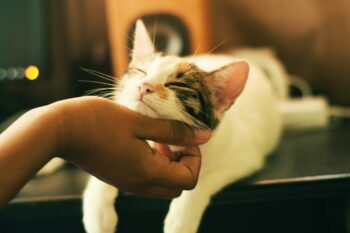It’s not so easy to think about the sense of touch on a creature covered with fur, but, like us, cats have touch receptors all over their bodies. These nerve cells transfer sensations of pressure, temperature, and pain from any point to the brain.
Cats are born with a highly developed sense of temperature, pressure and pain. This is especially important during the first 10 to 14 days of a kitten’s life, because their eyes are not yet open and they get around mainly by touch. Kittens have heat receptors on the skin at the tip of their nose that can detect temperature differences as small as 0.9 degrees F. These heat receptors tell a kitten where to crawl to find his mother.
The most sensitive places on the cat’s body, where the nerve cells are concentrated, are the face and the front paws. These are the most important body parts the cat uses while hunting. Your cat’s paws are exquisitely pressure-sensitive, and some researchers believe they can even sense tiny vibrations. They are also quite sensitive to the texture of cat litter.
Cats also experience sensation in their coat and skin. There are hot and cold receptors all over a cat’s skin, which is why kitty will wake up from a deep nap to move into a ray of sunlight. Each hair has many nerves around it which send impulses to the brain. Researchers have discovered that petting your cat evokes a very clear nervous system response: the heart rate slows, muscle tone drops, and the body relaxes. Digestion is enhanced as the digestive juices and saliva flows.
The cat’s whiskers, which are actually special hairs, are the most sensitive of all. These hairs, called tactile vibrissae, are set deep within the skin and provide the cat with sensory information about the slightest air movement around it. The whiskers are so delicately sensitive that if they move 1/2000th of the width of a human hair, they will send signals to the cat’s brain.
The whiskers are used for stalking, measuring and warning the cat about unseen obstacles. Whiskers detect wind and reflected air currents, and this information helps the cat locate his prey. In dim light, cats use their whiskers for navigation.
The whisker follicles also have specialized muscle attachments, giving the cat some control over whisker movement. When a cat is pouncing on his prey, the whiskers are pointed as far forward as possible. Because cats do not see particularly well at close range, the whiskers help the cat know exactly where his prey is and when it has stopped moving.







